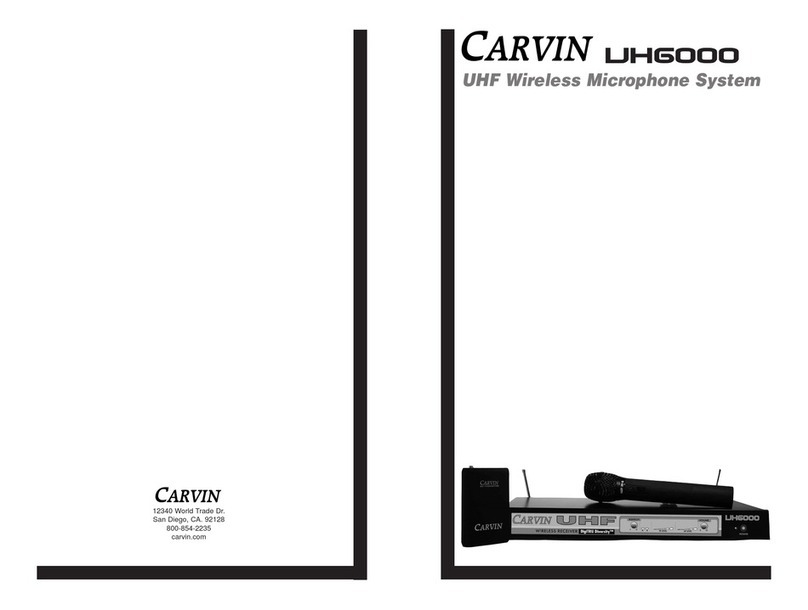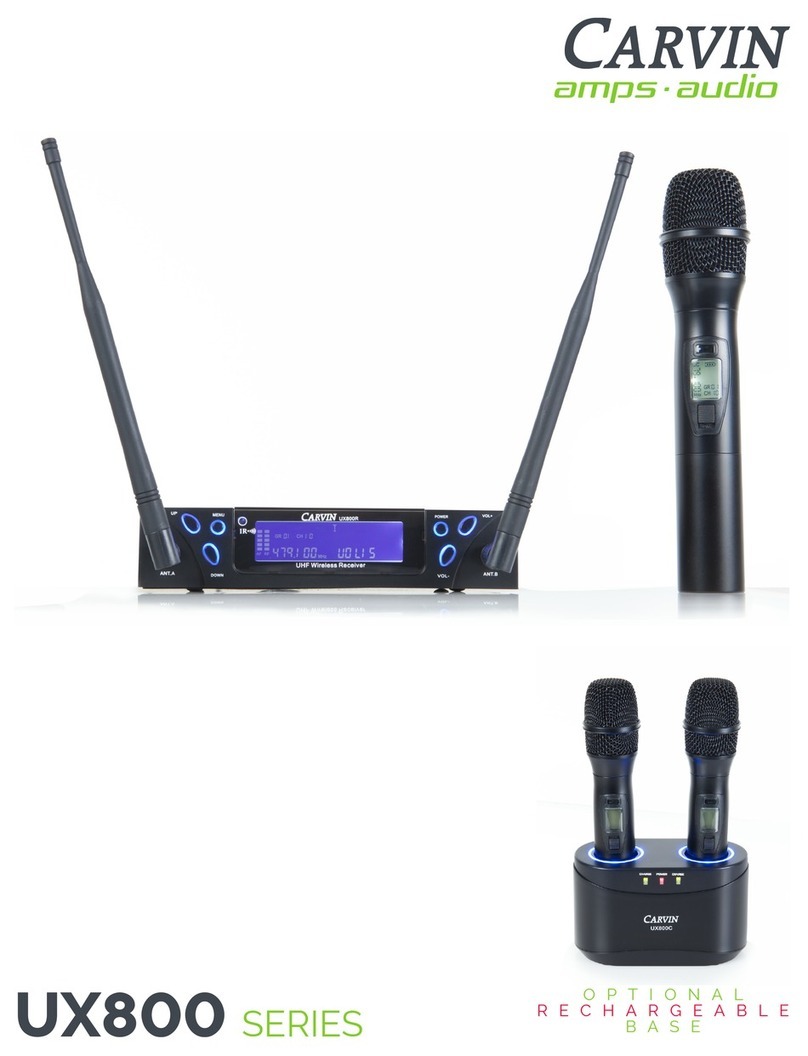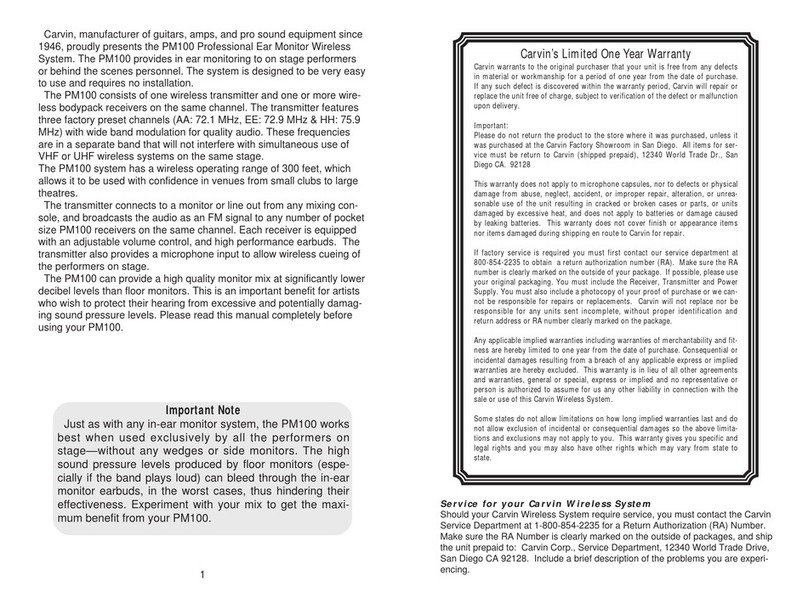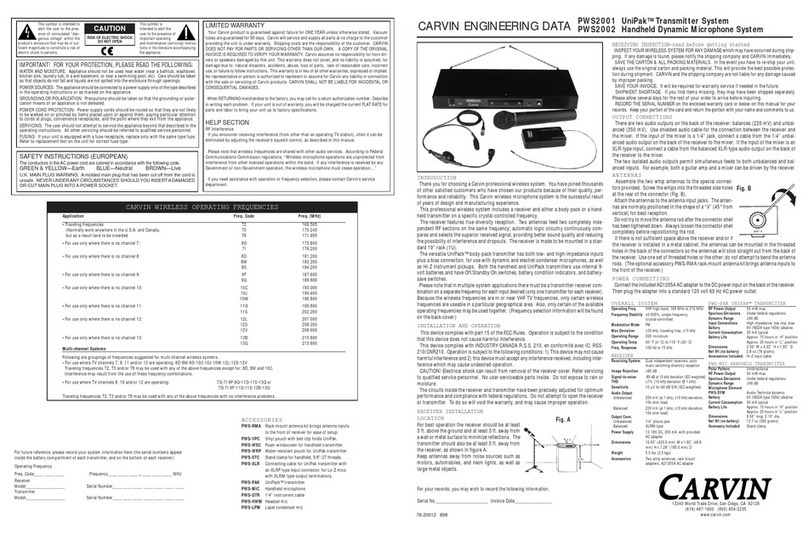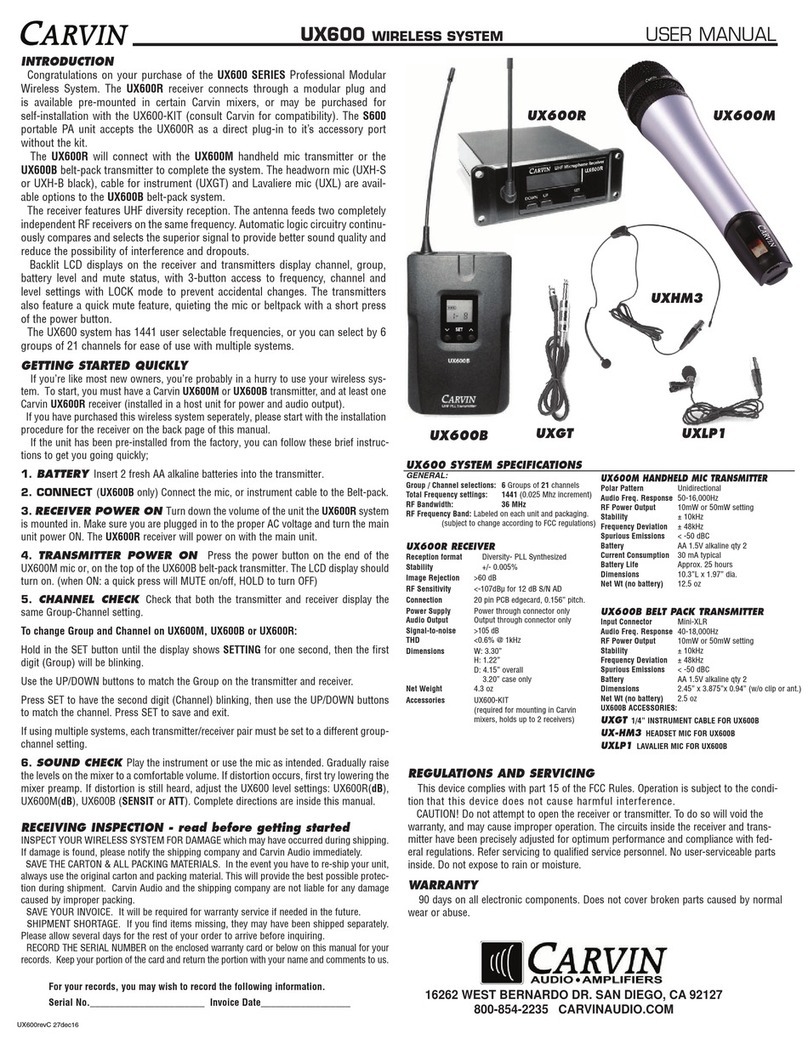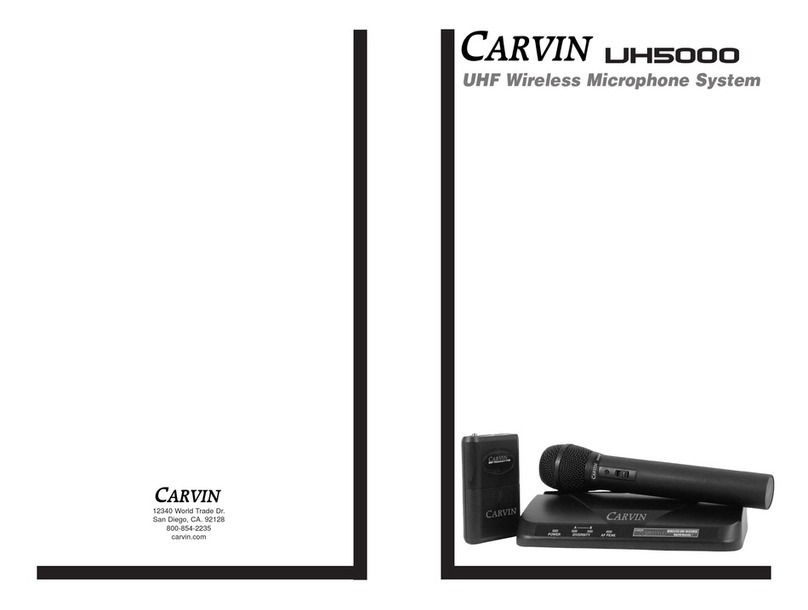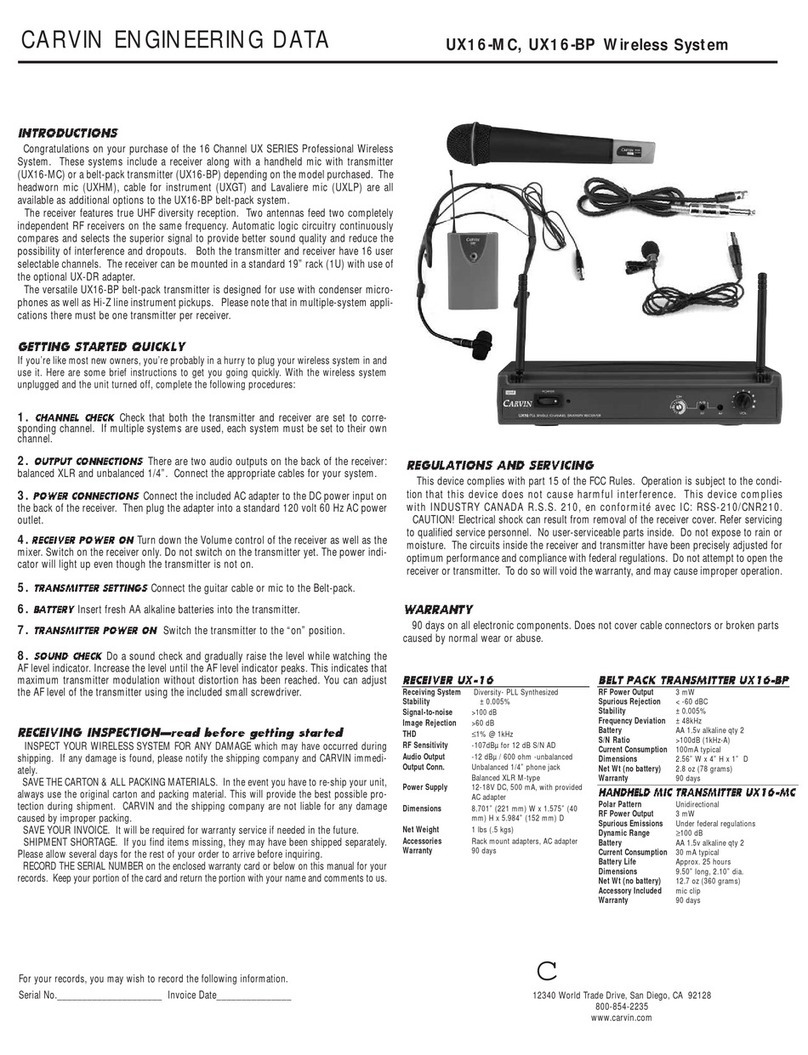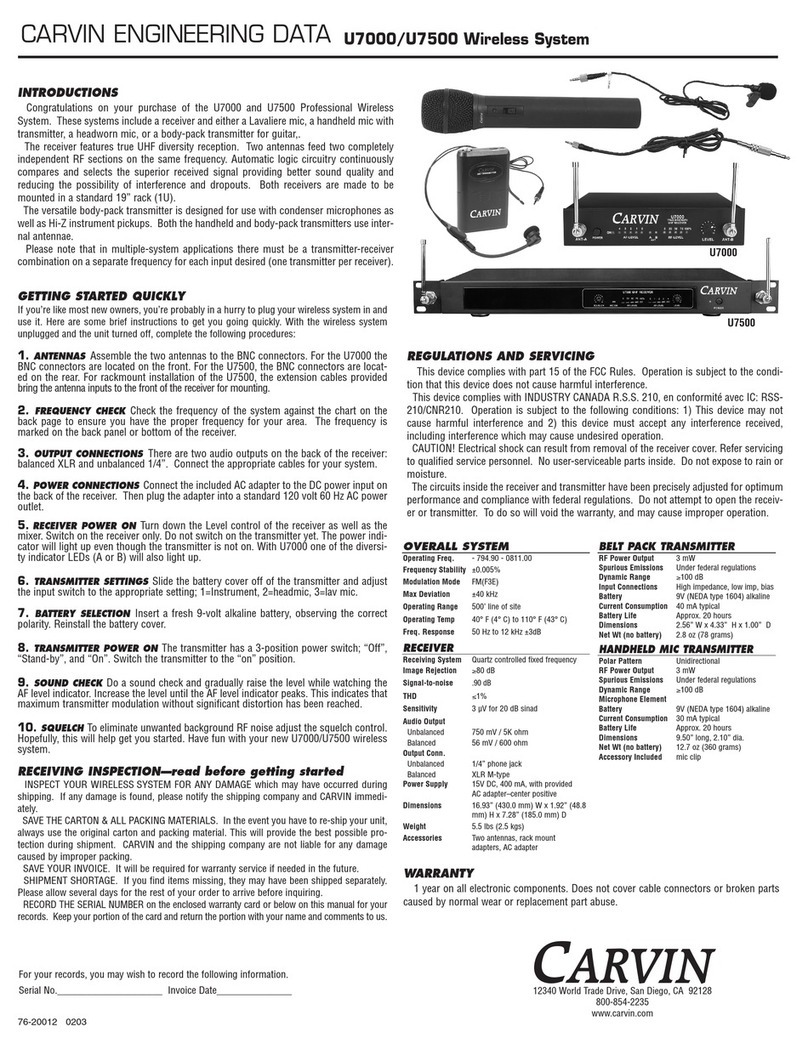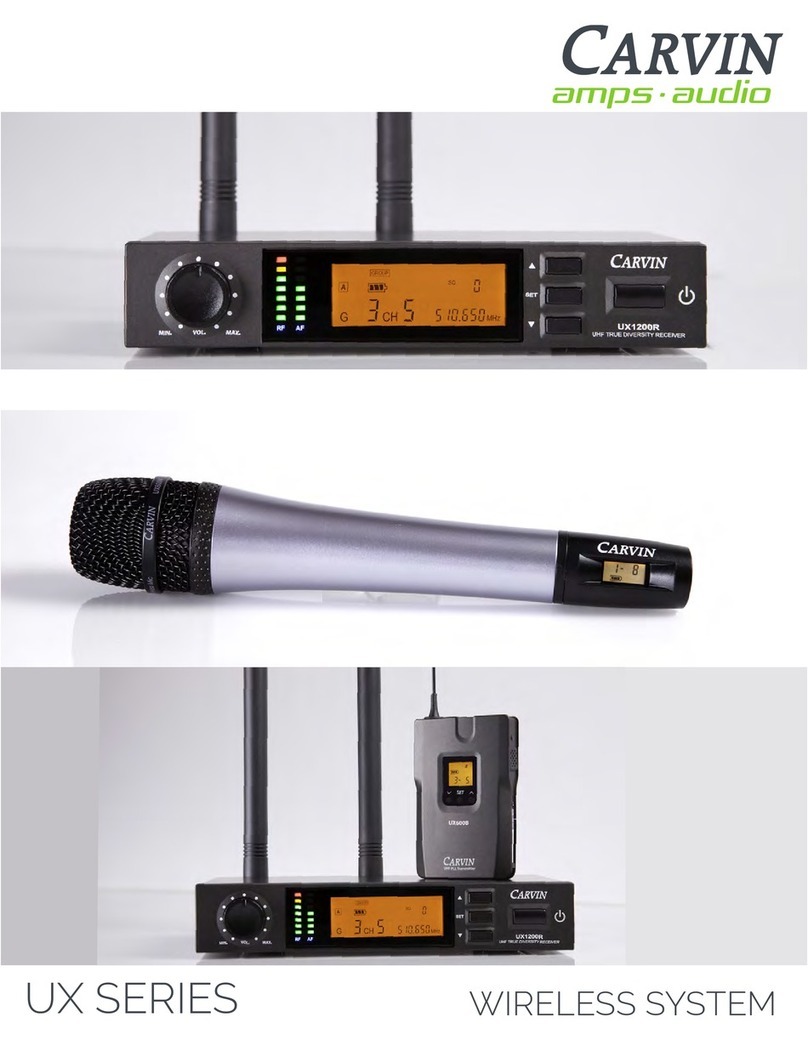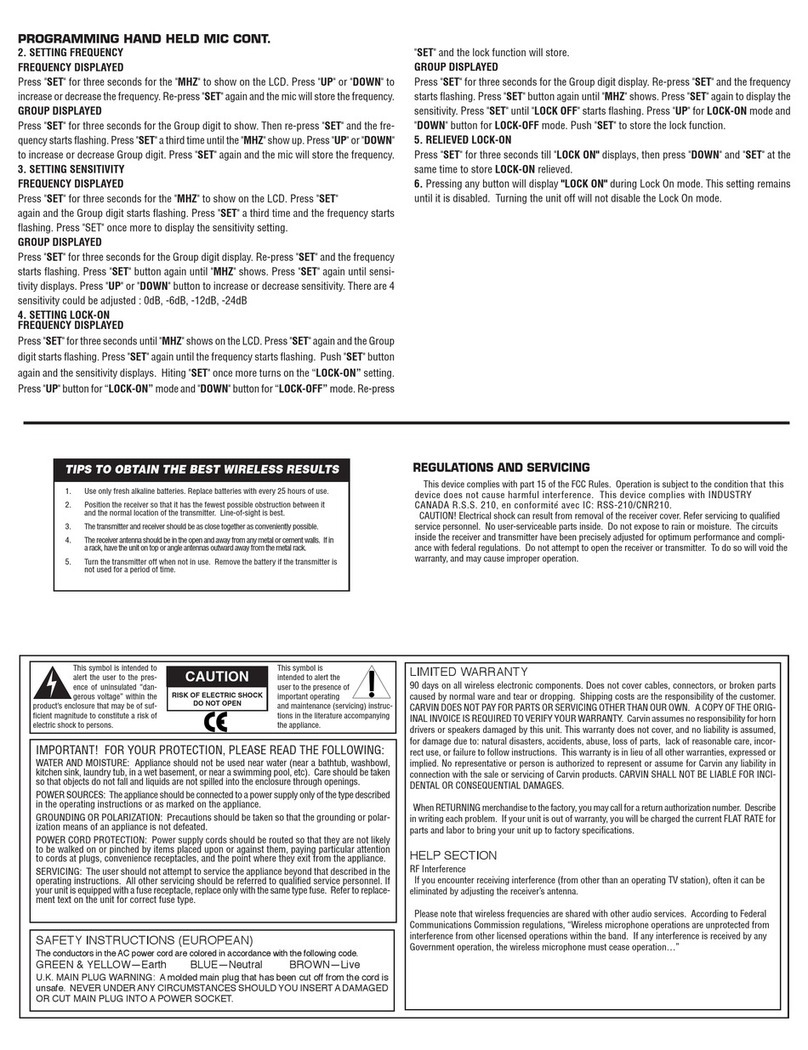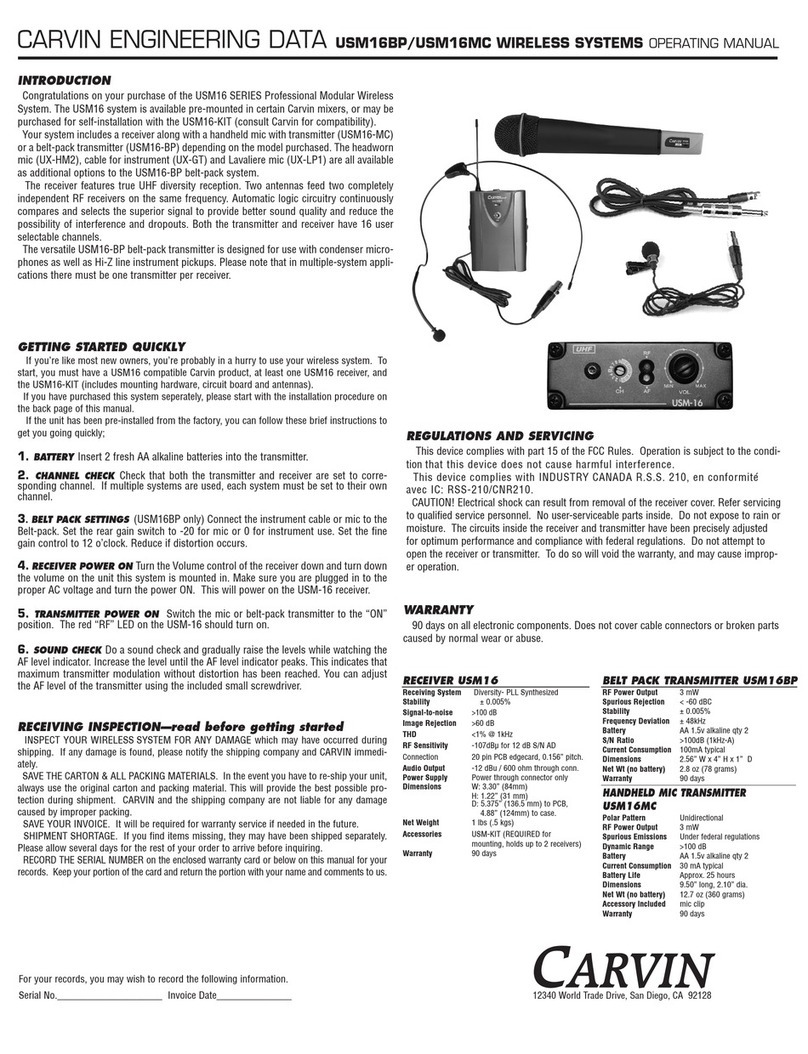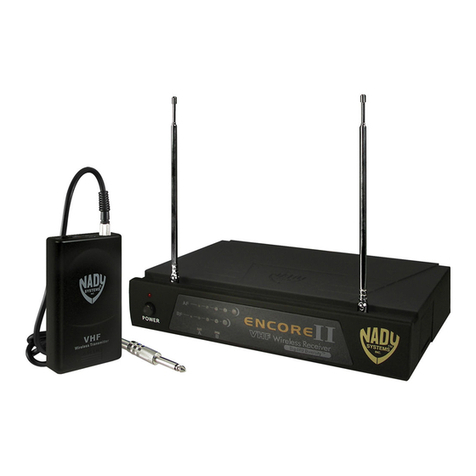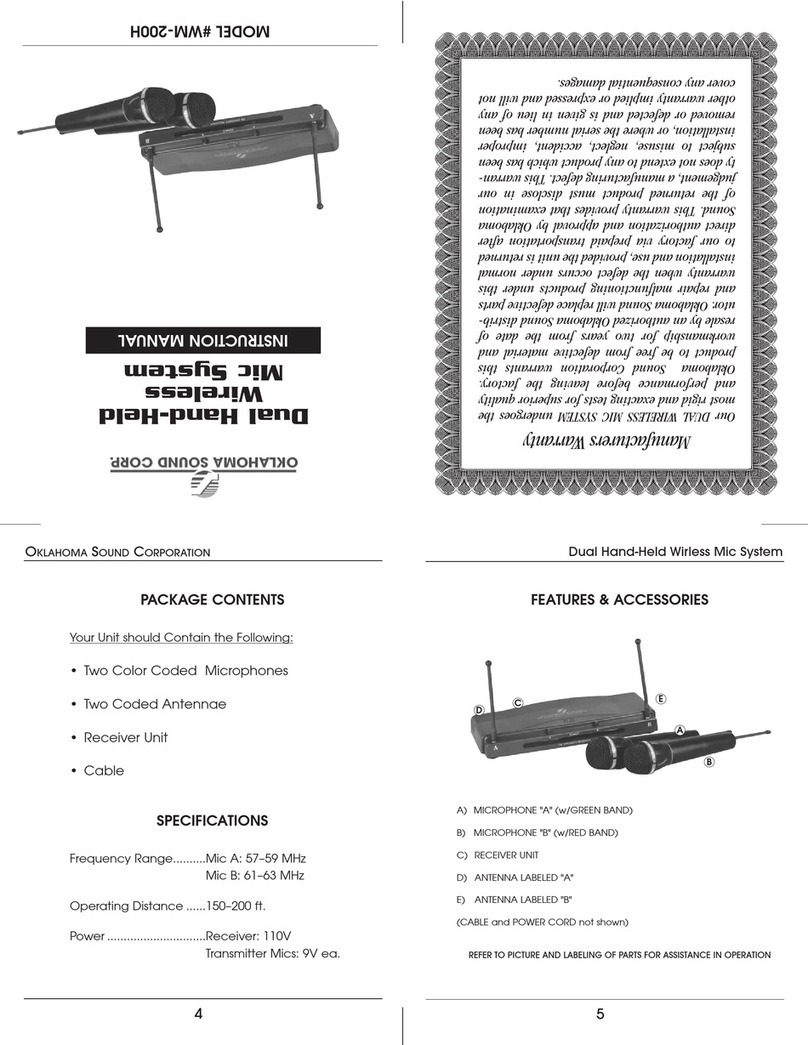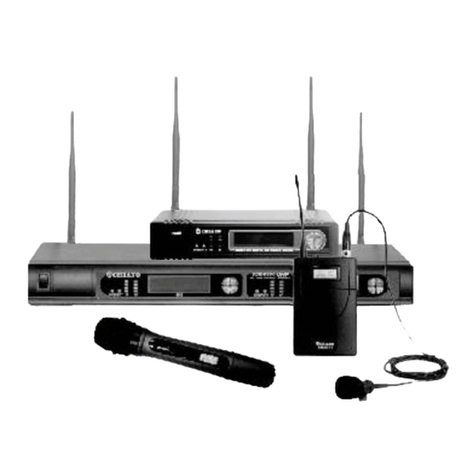OVERALL SYSTEM
Operating Freq. VHF high band, 169 MHz to 216 MHz
Frequency Stability ±0.005%, single-frequency
crystal-controlled
Modulation Mode FM
Max Deviation ±30 kHz, traveling freq. ±15 kHz
Operating Range 200’ minimum
Operating Temp 40° F (4° C) to 110° F (43° C)
Freq. Response 100 Hz to 15 kHz
RECEIVER
Receiving System Dual independent receivers, auto-
matic switching diversity reception
Image Rejection ≥60 dB
Signal-to-noise
.80 dB at 10 kHz deviation (IEC-weighted)
THD ≤1% (10 kHz deviation @ 1 kHz)
Sensitivity 10 µV for 60 dB S/N (IEC-weighted)
Audio Output
Unbalanced 350 mV (at 1 kHz, ±10 kHz deviation,
10k ohm load)
Balanced 220 mV (at 1 kHz, ±10 kHz deviation,
10k ohm load)
Output Conn.
Unbalanced 1/4” phone jack
Balanced XLRM-type
Power Supply 12-18V DC, 350 mA, with provided
AC adapter
Dimensions 16.93” (430.0 mm) W x 1.92” (48.8
mm) H x 7.28” (185.0 mm) D
Weight 5.5 lbs (2.5 kgs)
Accessories Two whip antennas, rack mount
adapters, AD1205A AC adapter
INTRODUCTION
Thank you for choosing a Carvin professional wireless system. You have joined thou-
sands of other satisfied customers who have chosen our products because of their quali-
ty, performance and reliability. This Carvin wireless microphone system is the successful
result of years of design and manufacturing experience.
This professional wireless system includes a receiver and either a body-pack or a hand-
held transmitter on a specific crystal-controlled frequency.
The receiver features true diversity reception. Two antennas feed two completely inde-
pendent RF sections on the same frequency; automatic logic circuitry continuously com-
pares and selects the superior received signal, providing better sound quality and reduc-
ing the possibility of interference and dropouts. The receiver is made to be mounted in a
standard 19” rack (1U).
The versatile UniPack™ body-pack transmitter has both low- and high-impedance inputs
plus a bias connection, for use with dynamic and electret condenser microphones, as well
as Hi-Z instrument pickups. Both the handheld and UniPack transmitters use internal 9-
volt batteries and have Off/Standby/On switches, battery condition indicators, and battery-
save switches.
Please note that in multiple-system applications there must be a transmitter-receiver
combination on a separate frequency for each input desired (only one transmitter for each
receiver). Because the wireless frequencies are in or near VHF TV frequencies, only cer-
tain wireless frequencies are useable in a particular geographical area. Also, only certain
of the available operating frequencies may be used together. (Frequency selection infor-
mation will be found on the back cover.)
INSTALLATION AND OPERATION
This device complies with part 15 of the FCC Rules. Operation is subject to the condi-
tion that this device does not cause harmful interference.
This device complies with INDUSTRY CANADA R.S.S. 210, en conformite´ avec IC: RSS-
210/CNR210. Operation is subject to the following conditions: 1) This device may not
cause harmful interference and 2) this device must accept any interference received,
including interference which may cause undesired operation.
CAUTION! Electrical shock can result from removal of the receiver cover. Refer servicing
to qualified service personnel. No user-serviceable parts inside. Do not expose to rain or
moisture.
The circuits inside the receiver and transmitter have been precisely adjusted for optimum
performance and compliance with federal regulations. Do not attempt to open the receiv-
er or transmitter. To do so will void the warranty, and may cause improper operation.
RECEIVER INSTALLATION
LOCATION
For best operation the receiver should be at least
3 ft. above the ground and at least 3 ft. away from
a wall or metal surface to minimize reflections.
The transmitter should also be at least 3 ft. away
from the receiver, as shown in figure A.
Keep antennas away from noise sources such as
motors, automobiles, and neon lights, as well as
large metal objects.
For your records, you may wish to record the following information.
Serial No._____________________ Invoice Date_______________
PWS-PAK UNIPAK™ TRANSMITTER
RF Power Output 50 mW max
Spurious Emissions Under federal regulations
Dynamic Range ≥90 dB
Input Connections High impedance, low imp, bias
Battery 9V (NEDA type 1604) alkaline
Current Consumption 30 mA typical
Battery Life Approx. 15 hours in “H” position
Approx. 20 hours in “L” position
Dimensions 2.56” W x 4.33” H x 1.00” D
Net Wt (no battery) 2.8 oz (78 grams)
Accessories Included Hi-Z input cable
PWS-MIC HANDHELD TRANSMITTER
Polar Pattern Unidirectional
RF Power Output 50 mW max
Spurious Emissions Under federal regulations
Dynamic Range ≥90 dB
Microphone Element
PWS-DYM Audio-Technica dynamic
Battery 9V (NEDA type 1604) alkaline
Current Consumption 30 mA typical
Battery Life Approx. 15 hours in “H” position
Approx. 20 hours in “L” position
Dimensions 9.50” long, 2.10” dia.
Net Wt (no battery) 12.7 oz (360 grams)
Accessory Included Stand clamp
76-20012 898
12340 World Trade Drive, San Diego, CA 92128
(619) 487-1600 (800) 854-2235
www.carvin.com
RECEIVING INSPECTION—read before getting started
INSPECT YOUR WIRELESS SYSTEM FOR ANY DAMAGE which may have occurred during
shipping. If any damage is found, please notify the shipping company and CARVIN immedi-
ately.
SAVE THE CARTON & ALL PACKING MATERIALS. In the event you have to re-ship your unit,
always use the original carton and packing material. This will provide the best possible pro-
tection during shipment. CARVIN and the shipping company are not liable for any damage
caused by improper packing.
SAVE YOUR INVOICE. It will be required for warranty service if needed in the future.
SHIPMENT SHORTAGE. If you find items missing, they may have been shipped separately.
Please allow several days for the rest of your order to arrive before inquiring.
RECORD THE SERIAL NUMBER on the enclosed warranty card or below on this manual for your
records. Keep your portion of the card and return the portion with your name and comments to us.
OUTPUT CONNECTIONS
There are two audio outputs on the back of the receiver: balances (220 mV) and unbal-
anced (350 mV). Use shielded audio cable for the connection between the receiver and
the mixer. If the input of the mixer is a 1/4” jack, connect a cable from the 1/4” unbal-
anced audio output on the back of the receiver to the mixer. If the input of the mixer is
an XLR-type input, connect a cable from the balanced XLR-type audio output on the back
of the receiver to the mixer.
The two isolated audio outputs permit simultaneous feeds to both unbalanced and bal-
anced inputs. For example, both a guitar amp and a mixer can be driven by the receiv-
er.
ANTENNAS
Assemble the two whip antennas to the special connec-
tors provided. Screw the whips into the threaded side
holes at the rear of the connector (Fig. B).
Attach the antennas to the antenna input jacks. The
antennas are normally positioned in the shape of a “V”
(45° from vertical) for best reception.
Do not try to move the antenna rod after the connector
shell has been tightened down. Always loosen the connector shell completely before
repositioning the rod.
If there is not sufficient space above the receiver and/or if the receiver is installed in a
metal cabinet, the antennas can be mounted in the threaded holes in the back of the con-
nectors so the antennas will stick straight out from the back of the receiver. Use one set
of threaded holes or the other; do not attempt to bend the antenna rods. (The optional
accessory PWS-RMA rack-mount antenna kit brings antenna inputs to the front of the
receiver.)
POWER CONNECTIONS
Connect the included AD1205A AC adapter to the DC power input on the back of the
CARVIN ENGINEERING DATA
PWS2001 UniPak™ Transmitter System
PWS2002 Handheld Dynamic Microphone System
Fig. B
Fig. A
